Generalife Palace and Gardens – upper & lower gardens, patio de la acequia
Explore the beauty of Generalife Palace and its serene Gardens
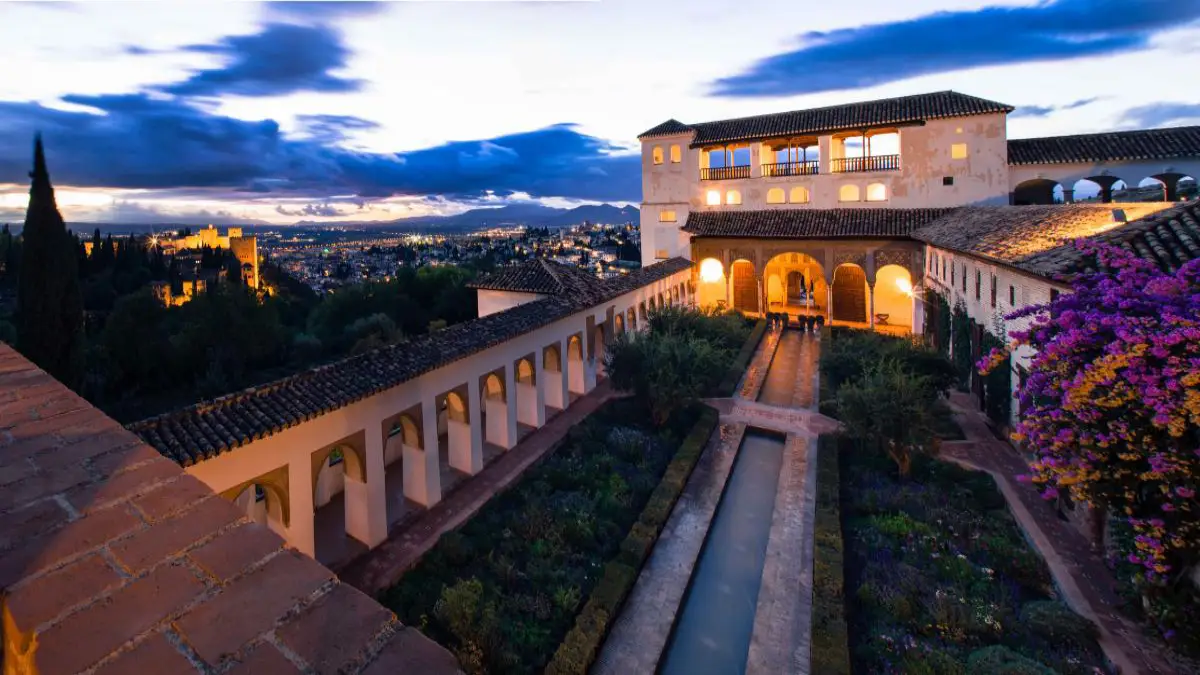
The Generalife Palace and Gardens are a peaceful and enchanting retreat located just beyond the walls of Alhambra in Granada.
Built in the 13th century as a summer residence for the Nasrid kings, the Generalife reflects the elegance of Islamic design, blending architecture, water, and nature in perfect harmony.
With its flowing water channels, terraced gardens, and simple yet beautiful palace, the Generalife feels very different from the grand and formal Alhambra.
In this article, we’ll explore the history, different sections, and special features that make the Generalife one of the most relaxing and charming spots in Andalusia.
The Alhambra Castle attracts over 2.6 million visitors annually, so booking in advance is a smart choice. The skip-the-line ticket is the most popular and budget-friendly option. For a deeper understanding of the palace, the guided tour offers expert insights, while the night tour provides a magical experience in a peaceful atmosphere.
History of Generalife Palace
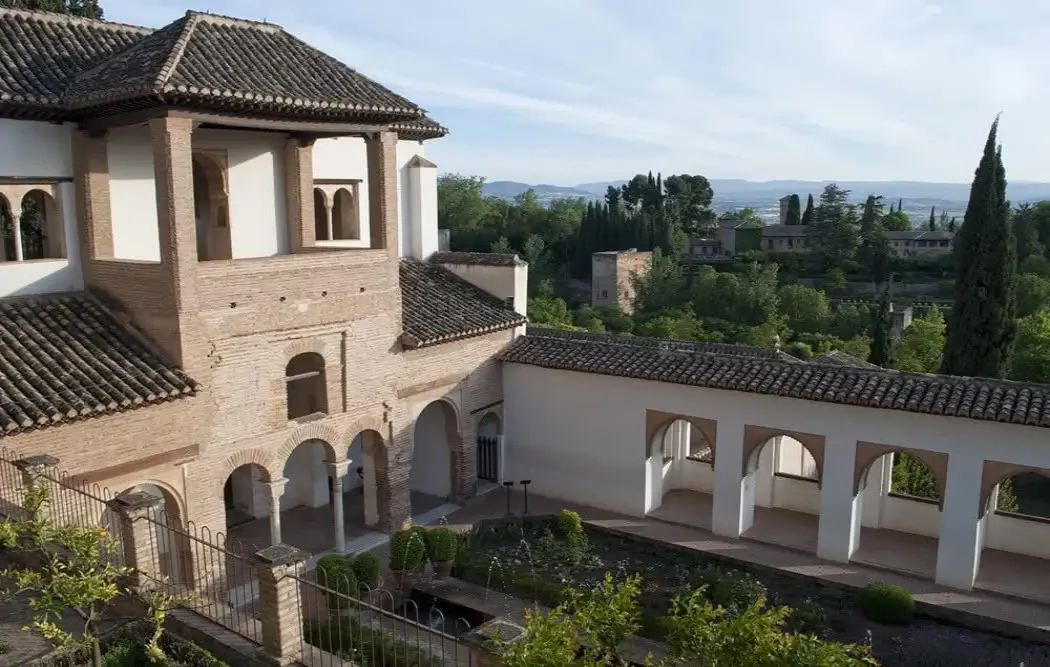
The Generalife Palace was built in the 13th century, likely during the Almohad period, and later expanded by Muhammad III, who added the famous Patio de la Acequia.
It served as the summer retreat for the Nasrid kings, offering a peaceful escape from the formal life of the Alhambra.
Unlike the richly decorated Alhambra, the Generalife is simpler and more modest, with elegant plasterwork and solid structures.
During the Christian period, especially under the Catholic Monarchs, many changes were made, including the addition of arches, modification of walls, and updates to the water features.
Over time, the Generalife underwent further alterations, especially in the 19th and 20th centuries, to preserve and enhance its beauty.
Despite being close to Alhambra, it was considered outside the city, and even witnessed a rebellion during Muhammad V’s stay.
Areas inside the Generalife gardens
The Generalife Gardens are divided into three main parts: the Lower Garden, the Generalife Palace, and the Upper Garden. Each section inside the Generalife gardens offers a unique blend of nature and architecture.
Lower garden of Generalife
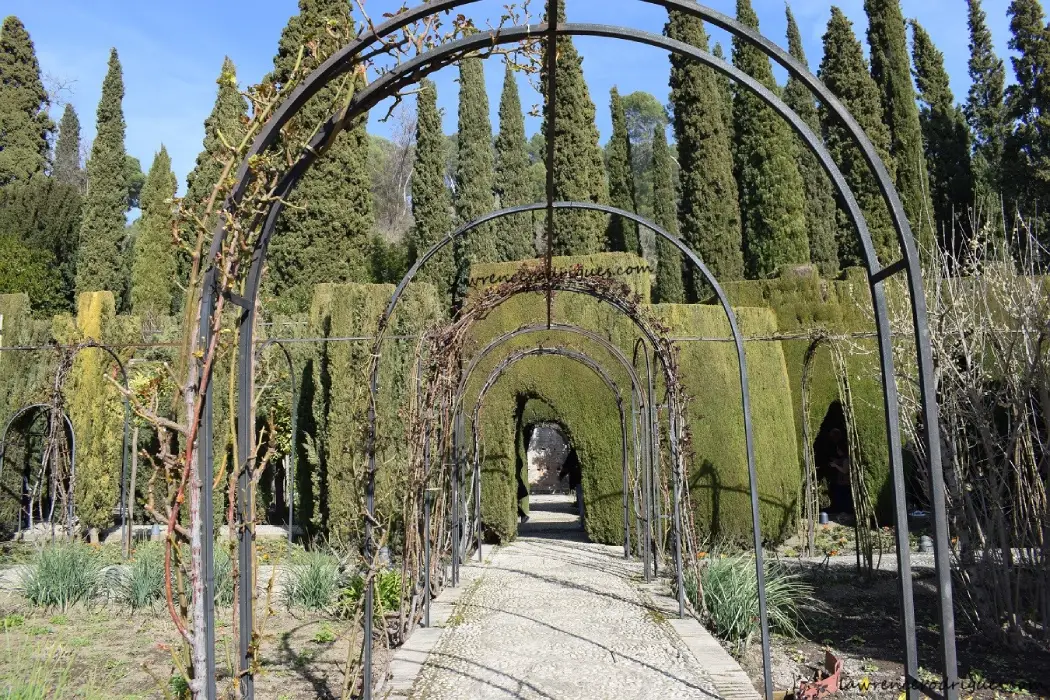
The Lower Garden is the first area visitors encounter in the Generalife. It stretches across three large terraces, each measuring 250 meters long and 35 meters wide, reflecting the Islamic love for symmetry.
The lower two terraces have been used as a market garden and orchard since the 14th century.
The top terrace, known as the Jardines Nuevos, was added in the 20th century and features cypress trees, pools, and the open-air Generalife Theatre, built in 1954.
This garden is perfect for a peaceful walk, with flower beds, fountains, and neatly trimmed hedges, blending history and beauty.
Generalife palace
The Generalife Palace is a hidden gem within the gardens, once used as a summer retreat by the Nasrid kings.
It is accessed through a small, decorated door, partly hidden by greenery, leading up a narrow staircase. The palace features fine marble, tiled lintels, and arched doorways.
It connects to the famous Patio de la Acequia (Court of the Water Channel), linking it to an arcaded gallery and the Royal Chamber (Sala Regia).
Known for its simple yet elegant Islamic architecture, the palace offers peaceful courtyards and flowing water features.
Designed as a private and quiet space, the Generalife provided the Nasrid rulers with a place for relaxation and reflection, away from the formal life of the Alhambra.
Upper garden of Generalife
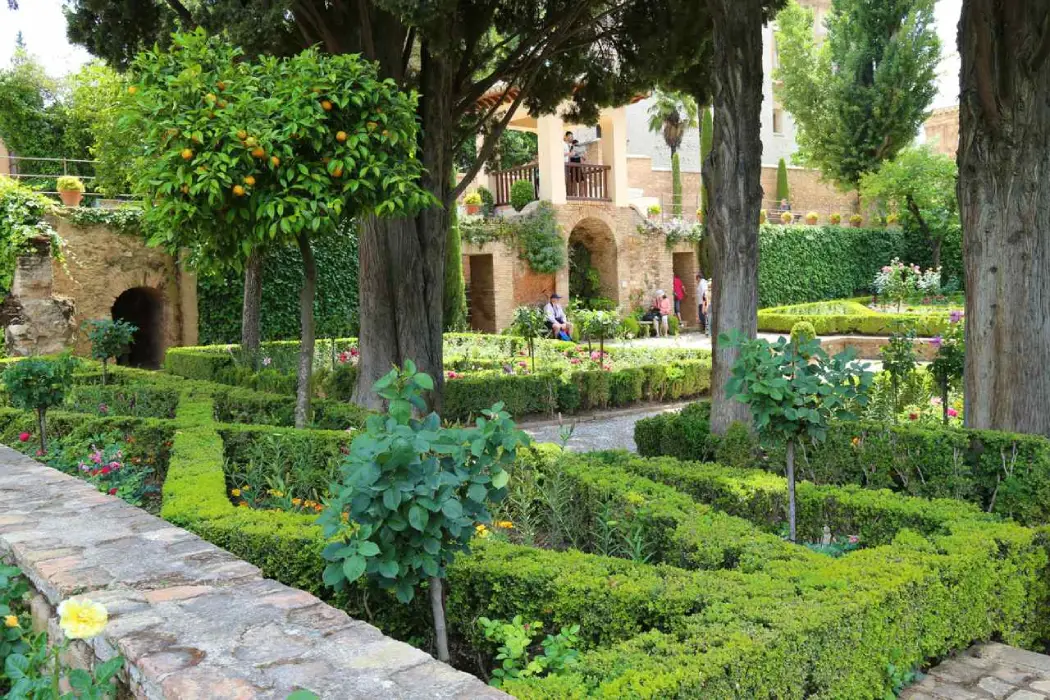
The Upper Garden, also known as the High Gardens, lies above the palace and is arranged in terraces along the hillside.
On the way up, visitors pass through the famous Water Stairway (Escalera del Agua), a unique 14th-century staircase with flowing water channels along its handrails, shaded by laurel trees.
This path leads to the charming Romantic Pavilion, a 19th-century addition. The garden area, known as the Jardines Altos, features shady walkways, lush greenery, and scenic views.
At the southeast end, the Paseo de las Adelfas (Walk of the Oleanders) guides visitors to the exit of the Generalife Gardens.
Patio de la Acequia (Court of the Water Channel)
The Patio de la Acequia is the most important part of the Generalife Palace, measuring about 48.7 meters long and 12.8 meters wide.
A water channel runs down the center, fed by the Alhambra’s irrigation system, with jets and stone basins at each end.
One side of the patio features a long wall with 18 arches, built around 1670, which was once part of a Christian chapel and now leads to a gallery and viewpoint.
The south pavilion, once the main entrance, is mostly in ruins, while the north pavilion includes a hall, portico, and tower with views of the gardens, possibly dating back to 1319.
In the Christian period, extra rooms were added for portraits, but they were removed in 1926, restoring the building’s original design.
Escalera del Agua (Water Stairway)
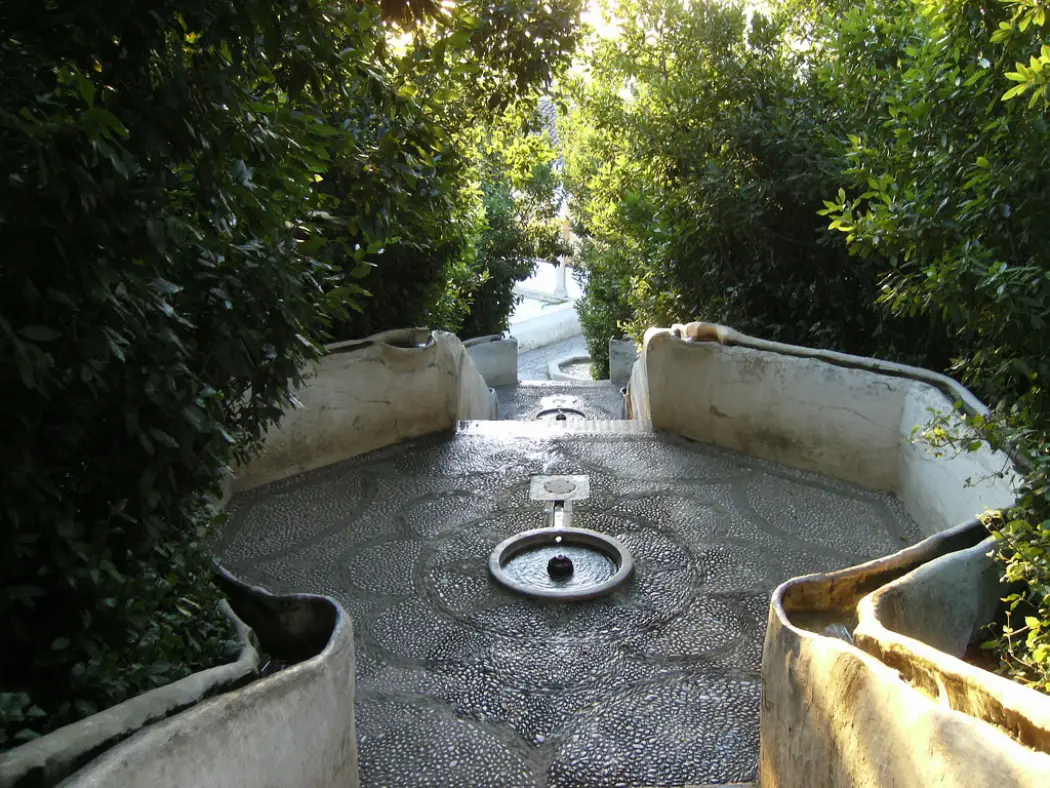
The Water Stairway is a beautiful outdoor staircase built in the 14th century in the Generalife Gardens, known for its water channels flowing along the handrails, creating a calm and refreshing atmosphere. The stairs are shaded by a canopy of laurel trees, keeping it cool and peaceful.
The staircase has three landings, each with a small round patio, a pool, and a fountain. Water also flows through a channel in the center of the steps into each pool.
Its Spanish name, “Escalera del Agua,” was first recorded in 1572 when the staircase was repaired.
Patio de los Cipreses (Court of the Sultana’s Cypress Tree)
The Court of the Sultana’s Cypress Tree is a quiet and romantic patio in the Generalife Gardens.
It has a U-shaped pond surrounded by myrtle hedges, and it was once the site of a palace bath that no longer exists. A small fountain once stood in the middle, and water still flows into the area through an old canal.
The patio is named after an ancient cypress tree, tied to a legend where Boabdil’s wife secretly met a knight from the Abencerrajes family beneath it, an affair said to have led to their tragic deaths.
The patio is shaded by verandas and cypress trees, creating a peaceful and mysterious atmosphere. A small door leads back to the Patio de la Acequia and the rest of the Generalife complex.
Generalife Theatre
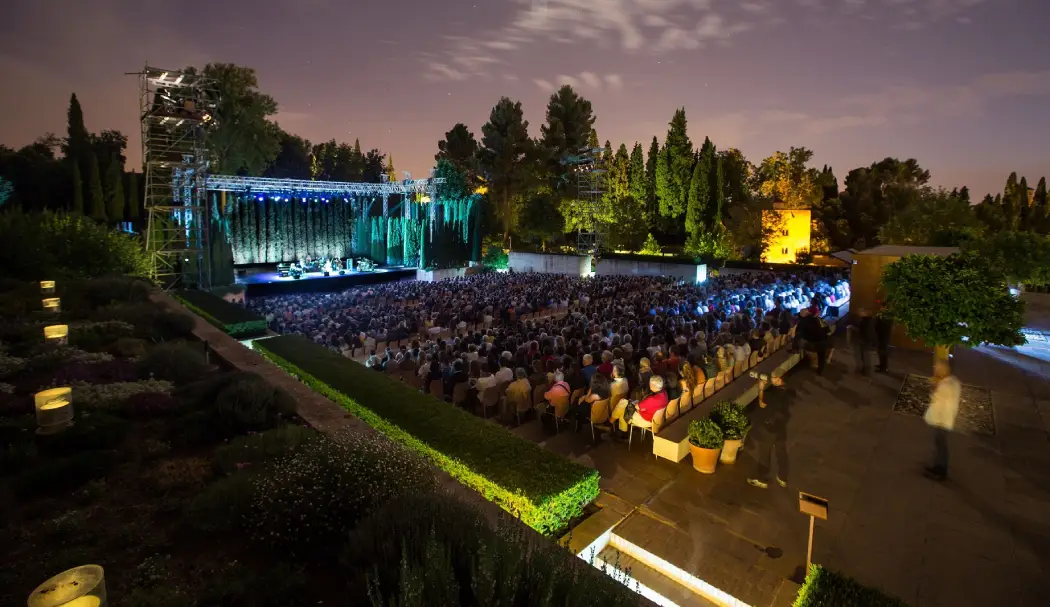
To host the International Festival of Music and Dance, the Generalife Gardens were extended to the south, and a large open-air theatre was built in 1954, designed by architect Francisco Prieto Moreno.
The theatre was inspired by Nasrid garden layouts (Riyadh) and became the main venue for ballet performances during the festival.
Over the years, the theatre has undergone several renovations, including a major restoration completed in 2005, to support more complex productions and meet modern audience needs.
The design blends beautifully with the Generalife Gardens, using cypress walls, terraces, and flowerbeds that integrate the stage into its natural surroundings. This setting gives the theatre a unique and elegant atmosphere, perfect for open-air performances.
Architecture of the Generalife Palace
The Generalife Palace reflects the simple and elegant Nasrid style, designed as a peaceful retreat rather than a grand royal residence.
Built in the 13th century and renovated in 1319, it features stone and plaster walls, wooden ceilings, and delicate stucco decoration.
The palace is centered around the Patio de la Acequia, with its long water channel and symmetrical garden layout. It includes two main pavilions, North and South, connected by arcaded galleries.
The architecture blends seamlessly with the surrounding terraced orchards and gardens, showing a strong connection between nature and structure, typical of Islamic design in Andalusia.
